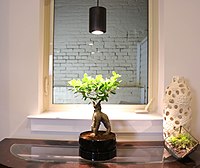
Photo from wikipedia
Characterizing spectral effects of blue and red light ratios on plants could help expand our understanding of factors that regulate growth and development, which is becoming increasingly important as narrowband… Click to show full abstract
Characterizing spectral effects of blue and red light ratios on plants could help expand our understanding of factors that regulate growth and development, which is becoming increasingly important as narrowband light-emitting diodes (LEDs) become common for sole-source lighting. Herein we report growth, physiological, and anatomical responses of two lettuce cultivars grown indoors under various blue and red ratios including monochromatic treatments. When used in combination with red, increasing the proportion of blue light generally reduced growth but increased chloroplast abundance and single-leaf photosynthetic efficiency. However, when used as single wavebands, both blue and red light increased leaf area and epidermal cell area, but reduced root dry mass, SPAD index, stomatal density, and leaf thickness compared to dichromatic light. In addition, chloroplast abundance and single-leaf physiological responses were higher in plants grown under monochromatic blue compared to red light, but the opposite trend was measured for shoot biomass. Our results show that spectral effects on morpho-anatomical leaf responses can largely influence plant growth and single-leaf physiological responses. However, a significant blue light reduction in radiation capture ultimately limits growth and productivity of lettuce plants when dichromatic blue and red light is used.
Journal Title: Physiologia plantarum
Year Published: 2021
Link to full text (if available)
Share on Social Media: Sign Up to like & get
recommendations!